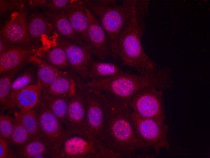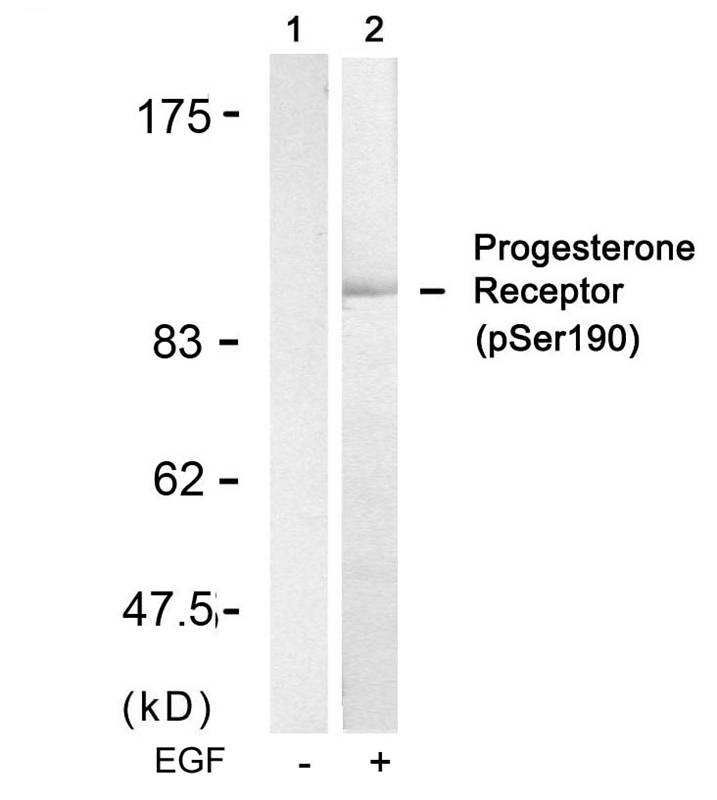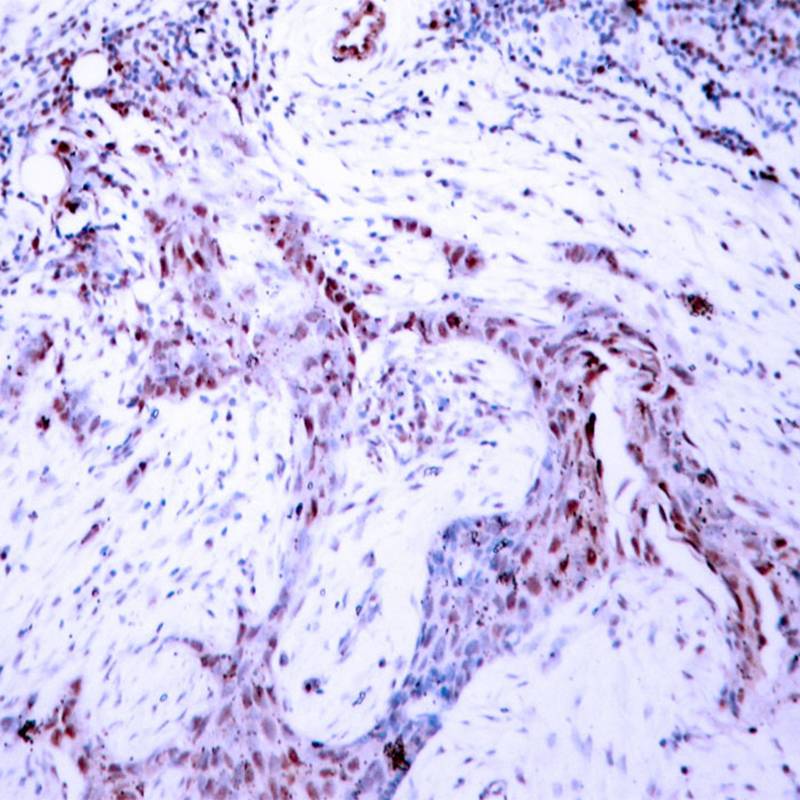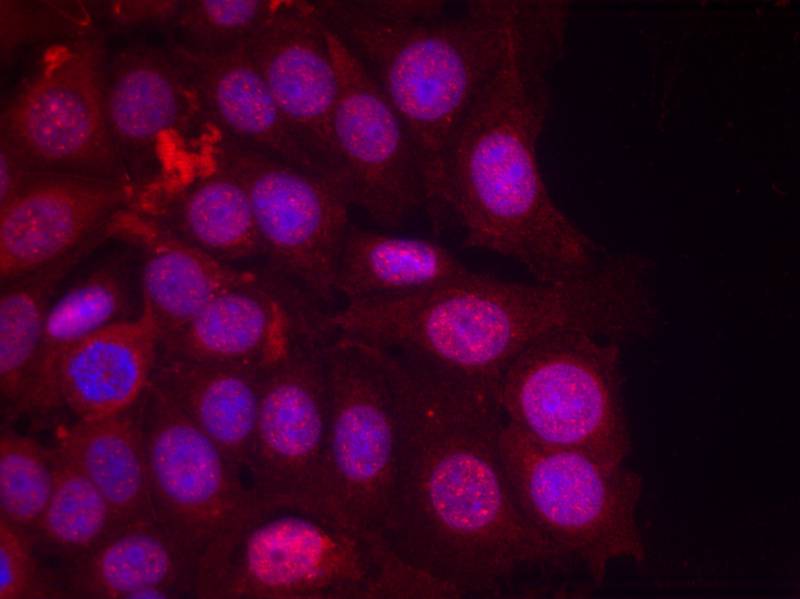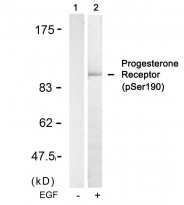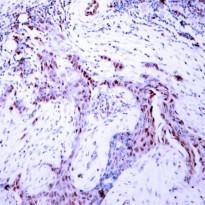anti-Progesterone Receptor phospho (Ser190) antibody
CAT.NO. : ARG51577
US$ Please choose
US$ Please choose
*产品价格可能会有所调整,请以品牌方官网实时更新的价格为准,以确保准确性。
概述
| 产品描述 | Rabbit Polyclonal antibody recognizes Progesterone Receptor phospho (Ser190) |
|---|---|
| 反应物种 | Hu |
| 应用 | ICC/IF, IHC-P, WB |
| 宿主 | Rabbit |
| 克隆 | Polyclonal |
| 同位型 | IgG |
| 靶点名称 | Progesterone Receptor |
| 抗原物种 | Human |
| 抗原 | Peptide sequence around phosphorylation site of serine 190 (G-L-S(p)-P-A) derived from Human Progesterone Receptor. |
| 偶联标记 | Un-conjugated |
| 別名 | PR; NR3C3; Nuclear receptor subfamily 3 group C member 3; Progesterone receptor |
应用说明
| 应用建议 |
| ||||||||
|---|---|---|---|---|---|---|---|---|---|
| 应用说明 | * The dilutions indicate recommended starting dilutions and the optimal dilutions or concentrations should be determined by the scientist. |
属性
| 形式 | Liquid |
|---|---|
| 纯化 | Antibodies were produced by immunizing rabbits with KLH-conjugated synthetic phosphopeptide. Antibodies were purified by affinity-chromatography using epitope-specific phosphopeptide. In addition, non-phospho specific antibodies were removed by chromatogramphy using non-phosphopeptide. |
| 缓冲液 | PBS (without Mg2+ and Ca2+, pH 7.4), 150mM NaCl, 0.02% Sodium azide and 50% Glycerol. |
| 抗菌剂 | 0.02% Sodium azide |
| 稳定剂 | 50% Glycerol |
| 浓度 | 1 mg/ml |
| 存放说明 | For continuous use, store undiluted antibody at 2-8°C for up to a week. For long-term storage, aliquot and store at -20°C. Storage in frost free freezers is not recommended. Avoid repeated freeze/thaw cycles. Suggest spin the vial prior to opening. The antibody solution should be gently mixed before use. |
| 注意事项 | For laboratory research only, not for drug, diagnostic or other use. |
生物信息
| 数据库连接 | |
|---|---|
| 基因名称 | PGR |
| 全名 | progesterone receptor |
| 背景介绍 | Progesterone receptors (PRs) are nuclear hormone receptors of the NR3C class, which also includes mineralocorticoid,glucocorticoid and androgen receptors. They exist as homodimers coupled to Hsp90 or HMGB proteins, which are shed upon activation. The major signaling pathway used by progesterone receptors is via direct DNA binding and transcriptional regulation of target genes. They can also signal by binding to other proteins, mainly with transcription factors such as NF-kappaB, AP-1 or STAT. Progesterone receptors are found in the female reproductive tract, mammary glands, brain and pituitary gland and receptor expression is induced by estrogen. Well established functions of progesterone receptors include ovulation, implantation, mammary gland development and maintenance of pregnancy. In addition,progesterone, signaling through the progesterone receptor, increases the ventilatory response of the respiratory centers to carbon dioxide and decreases arterial and alveolar PCO2 in the luteal phase of the menstrual cycle and during pregnancy. The human gene encoding the progesterone receptor has been localized to 11q22. |
| 生物功能 | The steroid hormones and their receptors are involved in the regulation of eukaryotic gene expression and affect cellular proliferation and differentiation in target tissues. Progesterone receptor isoform B (PRB) is involved activation of c-SRC/MAPK signaling on hormone stimulation. Isoform A: inactive in stimulating c-Src/MAPK signaling on hormone stimulation. Isoform 4: Increases mitochondrial membrane potential and cellular respiration upon stimulation by progesterone. [UniProt] |
| 研究领域 | Cancer antibody; Gene Regulation antibody; Neuroscience antibody; Signaling Transduction antibody |
| 预测分子量 | 99 kDa |
| 翻译后修饰 | Phosphorylated on multiple serine sites. Several of these sites are hormone-dependent. Phosphorylation on Ser-294 occurs preferentially on isoform B, is highly hormone-dependent and modulates ubiquitination and sumoylation on Lys-388. Phosphorylation on Ser-102 and Ser-345 also requires induction by hormone. Basal phosphorylation on Ser-81, Ser-162, Ser-190 and Ser-400 is increased in response to progesterone and can be phosphorylated in vitro by the CDK2-A1 complex. Increased levels of phosphorylation on Ser-400 also in the presence of EGF, heregulin, IGF, PMA and FBS. Phosphorylation at this site by CDK2 is ligand-independent, and increases nuclear translocation and transcriptional activity. Phosphorylation at Ser-162 and Ser-294, but not at Ser-190, is impaired during the G(2)/M phase of the cell cycle. Phosphorylation on Ser-345 by ERK1/2 MAPK is required for interaction with SP1. Sumoylation is hormone-dependent and represses transcriptional activity. Sumoylation on all three sites is enhanced by PIAS3. Desumoylated by SENP1. Sumoylation on Lys-388, the main site of sumoylation, is repressed by ubiquitination on the same site, and modulated by phosphorylation at Ser-294. Ubiquitination is hormone-dependent and represses sumoylation on the same site. Promoted by MAPK-mediated phosphorylation on Ser-294. Palmitoylated by ZDHHC7 and ZDHHC21. Palmitoylation is required for plasma membrane targeting and for rapid intracellular signaling via ERK and AKT kinases and cAMP generation. |
检测图片 (3)
ARG51577 anti-Progesterone Receptor phospho (Ser190) antibody WB image
Western blot: Extracts from SKOV3 cells untreated(lane 1) or treated with EGF(lane 2) stained with ARG51577 anti-Progesterone Receptor phospho (Ser190) antibody.
ARG51577 anti-Progesterone Receptor phospho (Ser190) antibody IHC-P image
Immunohistochemistry: Paraffin-embedded Human breast carcinoma tissue stained with ARG51577 anti-Progesterone Receptor phospho (Ser190) antibody.
ARG51577 anti-Progesterone Receptor phospho (Ser190) antibody ICC/IF image
Immunofluorescence: methanol-fixed MCF cells stained with ARG51577 anti-Progesterone Receptor phospho (Ser190) antibody.
 New Products
New Products




